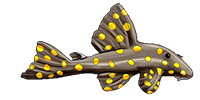I have some questions about filtration for the 2 meter tank i am going to set up...Unfortunately i may make it 200x60x70 instead of 200x90x70 for now but i will upgrade it to 200x90x70 as soon as Panaques reach 20cm in size which i know it wont take them much,probably only 2-3 years...And then again when they pass 30cm it will be upgraded again
Although i will make it smaller,it will do have a 200-250litter sump and a 250-300litter holding tank for water preparation...The fish stocking will probably be what i planned for the bigger one,although i may put 3 Panaque L190 instead of 4 and 3 Leporacanthicus L240 instead of 4.The other fishes will remain the same,which is 15-20 Copella compta and 4 Hemiancistrus subviridis.
For filtration i am planning to go with:
1 Fluidized bed filter designed for at least 600gallons of water
1 Eheim professional 3 electronic 2078(designed for 700litter vollume)
1 Eheim wet/dry 2229(designed for 600litter vollume)
Do you think they will be enough filtration with these?There will also be some powerheads in the tank with sponge prefilters and so they may help too...
Also i would like to ask you which fluidized bed filter you think its best:Lifeguard,Merlin or Emperor?
Thank you very much in advance




